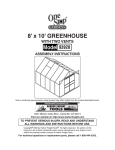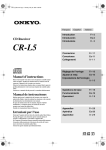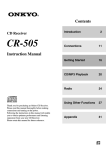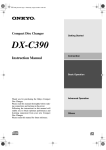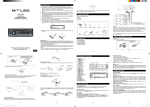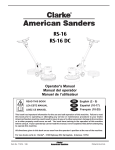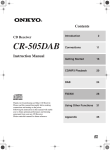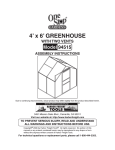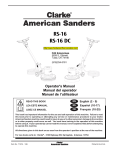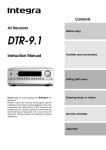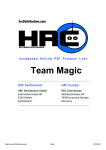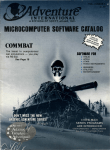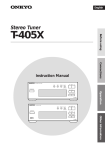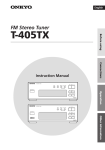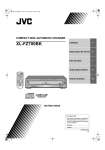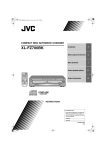Download Onkyo CR-L5 User's Manual
Transcript
CR-L5_E.book Page 1 Monday, May 19, 2003 4:05 PM Contents Introduction CD Receiver CR-L5 Important Safeguards .................................... 2 Precautions .................................................... 4 Features ......................................................... 5 Supplied Accessories .................................... 6 Disc Notes ..................................................... 6 Before Using the CR-L5 ............................... 7 Controls & Connectors.................................. 8 Instruction Manual Connections Connecting Your Other Components to the CR-L5 ...................................................... 11 Connecting -compatible Components ... 12 Connecting Your Speakers.......................... 13 Connecting Antenna.................................... 14 Setting the Clock Powering Up and Setting the Clock ............ 16 Operation Thank you for purchasing the Onkyo CD Receiver. Please read this manual thoroughly before making connections and turning on the power. Following the instructions in this manual will enable you to obtain optimum performance and listening enjoyment from your new CD Receiver. Please retain this manual for future reference. Using the CR-L5 ......................................... 19 Playing CDs ................................................ 20 Using the Radio........................................... 22 Other Functions........................................... 25 Timers ......................................................... 26 Appendix Troubleshooting .......................................... 29 Specifications .............................................. 32 En CR-L5_E.book Page 2 Monday, May 19, 2003 4:05 PM WARNING: TO REDUCE THE RISK OF FIRE OR ELECTRIC SHOCK, DO NOT EXPOSE THIS APPLIANCE TO RAIN OR MOISTURE. CAUTION: TO REDUCE THE RISK OF ELECTRIC SHOCK, DO NOT REMOVE COVER (OR BACK). NO USER-SERVICEABLE PARTS INSIDE. REFER SERVICING TO QUALIFIED SERVICE PERSONNEL. WARNING AVIS RISK OF ELECTRIC SHOCK DO NOT OPEN RISQUE DE CHOC ELECTRIQUE NE PAS OUVRIR The lightning flash with arrowhead symbol, within an equilateral triangle, is intended to alert the user to the presence of uninsulated “dangerous voltage” within the product’s enclosure that may be of sufficient magnitude to constitute a risk of electric shock to persons. The exclamation point within an equilateral triangle is intended to alert the user to the presence of important operating and maintenance (servicing) instructions in the literature accompanying the appliance. Important Safeguards 1. Read Instructions—All the safety and operating instructions should be read before the appliance is operated. 2. Retain Instructions—The safety and operating instructions should be retained for future reference. 3. Heed Warnings—All warnings on the appliance and in the operating instructions should be adhered to. 4. Follow Instructions—All operating and use instructions should be followed. 5. Cleaning—Unplug the appliance from the wall outlet before cleaning. The appliance should be cleaned only as recommended by the manufacturer. 6. Attachments—Do not use attachments not recommended by the appliance manufacturer as they may cause hazards. 7. Water and Moisture—Do not use the appliance near water –for example, near a bath tub, wash bowl, kitchen sink, or laundry tub; in a wet basement; or near a swimming pool; and the like. 8. Accessories—Do not place the appliance on an unstable cart, stand, tripod, bracket, or table. The appliance may fall, causing serious injury to a child or adult, and serious damage to the appliance. Use only with a cart, stand, tripod, bracket, or table recommended by the manufacturer, or sold with the appliance. Any mounting of the appliance should follow the manufacturer’s instructions, and should use a mounting accessory recommended by the manufacturer. 9. An appliance and cart combiPORTABLE CART WARNING nation should be moved with care. Quick stops, excessive force, and uneven surfaces may cause the appliance and cart combination to overturn. S3125A 10. Ventilation—Slots and openings in the cabinet are provided for ventilation and to ensure reliable operation of the appliance and to protect it from overheating, and these openings must not be blocked or covered. The openings should never be blocked by placing the appliance on a bed, sofa, rug, or other similar surface. The appliance should not be placed in a built-in installation such as a bookcase or rack unless proper ventilation is provided. There should be free space of at least 8 in. (20 cm) and an opening behind the appliance. 2 11. Power Sources—The appliance should be operated only from the type of power source indicated on the marking label. If you are not sure of the type of power supply to your home, consult your appliance dealer or local power company. 12. Grounding or Polarization—The appliance may be equipped with a polarized alternating current line plug (a plug having one blade wider than the other). This plug will fit into the power outlet only one way. This is a safety feature. If you are unable to insert the plug fully into the outlet, try reversing the plug. If the plug should still fail to fit, contact your electrician to replace your obsolete outlet. Do not defeat the safety purpose of the polarized plug. 13. Power Cord Protection—Power-supply cords should be routed so that they are not likely to be walked on or pinched by items placed upon or against them, paying particular attention to cords at plugs, convenience receptacles, and the point where they exit from the appliance. 14. Outdoor Antenna Grounding—If an outside antenna or cable system is connected to the appliance, be sure the antenna or cable system is grounded so as to provide some protection against voltage surges and built-up static charges. Article 810 of the National Electrical Code, ANSI/NFPA 70, provides information with regard to proper grounding of the mast and supporting structure, grounding of the lead-in wire to an antennadischarge unit, size of grounding conductors, location of antenna-discharge unit, connection to grounding electrodes, and requirements for the grounding electrode. See Figure 1. 15. Lightning—For added protection for the appliance during a lightning storm, or when it is left unattended and unused for long periods of time, unplug it from the wall outlet and disconnect the antenna or cable system. This will prevent damage to the appliance due to lightning and power-line surges. 16. Power Lines—An outside antenna system should not be located in the vicinity of overhead power lines or other electric light or power circuits, or where it can fall into such power lines or circuits. When installing an outside antenna system, extreme care should be taken to keep from touching such power lines or circuits as contact with them might be fatal. 17. Overloading—Do not overload wall outlets, extension cords, or integral convenience receptacles as this can result in a risk of fire or electric shock. CR-L5_E.book Page 3 Monday, May 19, 2003 4:05 PM Important Safeguards—Continued 18. Object and Liquid Entry—Never push objects of any kind into the appliance through openings as they may touch dangerous voltage points or short-out parts that could result in a fire or electric shock. Never spill liquid of any kind on the appliance. 19. Servicing—Do not attempt to service the appliance yourself as opening or removing covers may expose you to dangerous voltage or other hazards. Refer all servicing to qualified service personnel. 20. Damage Requiring Service—Unplug the appliance form the wall outlet and refer servicing to qualified service personnel under the following conditions: A. When the power-supply cord or plug is damaged, B. If liquid has been spilled, or objects have fallen into the appliance, C. If the appliance has been exposed to rain or water, D. If the appliance does not operate normally by following the operating instructions. Adjust only those controls that are covered by the operating instructions as an improper adjustment of other controls may result in damage and will often require extensive work by a qualified technician to restore the appliance to its normal operation, E. If the appliance has been dropped or damaged in any way, and F. When the appliance exhibits a distinct change in performance – this indicates a need for service. 21. Replacement Parts—When replacement parts are required, be sure the service technician has used replacement parts specified by the manufacturer or have the same characteristics as the original part. Unauthorized substitutions may result in fire, electric shock, or other hazards. 22. Safety Check—Upon completion of any service or repairs to the appliance, ask the service technician to perform safety checks to determine that the appliance is in proper operation condition. 23. Wall or Ceiling Mounting—The appliance should be mounted to a wall or ceiling only as recommended by the manufacturer. 24. Heat—The appliance should be situated away from heat sources such as radiators, heat registers, stoves, or other appliances (including amplifiers) that produce heat. 25. Liquid Hazards—The appliance should not be exposed to dripping or splashing and no objects filled with liquids, such as vases should be placed on the appliance. FIGURE 1: EXAMPLE OF ANTENNA GROUNDING AS PER NATIONAL ELECTRICAL CODE, ANSI/NFPA 70 ANTENNA LEAD IN WIRE GROUND CLAMP ANTENNA DISCHARGE UNIT (NEC SECTION 810-20) ELECTRIC SERVICE EQUIPMENT GROUNDING CONDUCTORS (NEC SECTION 810-21) GROUND CLAMPS NEC – NATIONAL ELECTRICAL CODE S2898A POWER SERVICE GROUNDING ELECTRODE SYSTEM (NEC ART 250, PART H) 3 CR-L5_E.book Page 4 Monday, May 19, 2003 4:05 PM Precautions 1. Recording Copyright Unless it’s for personal use only, recording copyrighted material is illegal without the permission of the copyright holder. 2. AC Fuse The AC fuse inside the CR-L5 is not user-serviceable. If you cannot turn on the CR-L5, contact your Onkyo dealer. 3. Care Occasionally you should dust the CR-L5 all over with a soft cloth. For stubborn stains, use a soft cloth dampened with a weak solution of mild detergent and water. Dry the CR-L5 immediately afterwards with a clean cloth. Don’t use abrasive cloths, thinners, alcohol, or other chemical solvents, because they may damage the finish or remove the panel lettering. 4. Power WARNING BEFORE PLUGGING IN THE UNIT FOR THE FIRST TIME, READ THE FOLLOWING SECTION CAREFULLY. AC outlet voltages vary from country to country. Make sure that the voltage in your area meets the voltage requirements printed on the CR-L5’s rear panel (AC 230 V, 50 Hz). Setting the [STANDBY/ON] switch to STANDBY does not fully shutdown the CR-L5. If you do not intend to use the CR-L5 for an extended period, remove the power cord from the AC outlet. 5. Never Touch This Unit with Wet Hands Never handle this unit or its power cord while your hands are wet or damp. If water or any other liquid gets inside this unit, have it checked by your Onkyo dealer. 6. Installing This Unit • Install this unit in a well-ventilated location. • Ensure that there’s adequate ventilation all around this unit, especially if it’s installed in an audio rack. If the ventilation is inadequate, the unit may overheat, leading to malfunction. • Do not expose this unit to direct sunlight or heat sources, because its internal temperature may rise, shortening the life of the optical pickup. • Avoid damp and dusty places, and places subject to vibrations from loudspeakers. Never put the unit on top of, or directly above a loudspeaker. • Install this unit horizontally. Never use it on its side or on a sloping surface, because it may cause a malfunction. • If you install this unit near a TV, radio, or VCR, the sound quality may be affected. If this occurs, move this unit away from the TV, radio, or VCR. 4 7. Moisture Condensation Moisture condensation may damage this unit. Read the following carefully: When you take a glass containing a cold drink outside on a summer’s day, drops of water, called condensation, form on the outside of the glass. Similarly, moisture may condense on the lens of the optical pickup, one of the most important parts inside this unit. • Moisture condensation can occur in the following situations: — The unit is moved from a cold place to a warm place. — A heater is turned on, or cold air from an air conditioner is hitting the unit. — In the summer, when this unit is moved from an air conditioned room to a hot and humid place. — The unit is used in a humid place. • Do not use this unit when there’s the possibility of moisture condensation occurring. Doing so may damage your discs and certain parts inside this unit. If condensation does occur, remove all discs and leave this unit turned on for two to three hours. By this time, the unit will have warmed up and any condensation will have evaporated. To reduce the risk of condensation, keep this unit connected to a wall outlet. For British models Replacement and mounting of an AC plug on the power supply cord of this unit should be performed only by qualified service personnel. IMPORTANT The wires in the mains lead are coloured in accordance with the following code: Blue: Neutral Brown: Live As the colours of the wires in the mains lead of this apparatus may not correspond with the coloured markings identifying the terminals in your plug, proceed as follows: The wire which is coloured blue must be connected to the terminal which is marked with the letter N or coloured black. The wire which is coloured brown must be connected to the terminal which is marked with the letter L or coloured red. IMPORTANT A 5 ampere fuse is fitted in this plug. Should the fuse need to be replaced, please ensure that the replacement fuse has a rating of 5 amperes and that it is approved by ASTA or BSI to BS1362. Check for the ASTA mark or the BSI mark on the body of the fuse. IF THE FITTED MOULDED PLUG IS UNSUITABLE FOR THE SOCKET OUTLET IN YOUR HOME THEN THE FUSE SHOULD BE REMOVED AND THE PLUG CUT OFF AND DISPOSED OF SAFELY. THERE IS A DANGER OF SEVERE ELECTRICAL SHOCK IF THE CUT OFF PLUG IS INSERTED INTO ANY 13 AMPERE SOCKET. If in any doubt, consult a qualified electrician. CR-L5_E.book Page 5 Monday, May 19, 2003 4:05 PM Precautions—Continued This unit contains a semiconductor laser system and is classified as a “CLASS 1 LASER PRODUCT.” So, to use this model properly, read this Instruction Manual carefully. In case of any trouble, please contact the store where you purchased the unit. To prevent exposure to the laser beam, do not try to open the enclosure. DANGER: VISIBLE AND INVISIBLE LASER RADIATION WHEN OPEN AND INTERLOCK FAILED OR DEFEATED. DO NOT STARE INTO BEAM. Declaration of Conformity We, ONKYO EUROPE ELECTRONICS GmbH LIEGNITZERSTRASSE 6, 82194 GROEBENZELL, GERMANY declare in own responsibility, that the ONKYO product described in this instruction manual is in compliance with the corresponding technical standards such as EN60065, EN55013, EN55020 and EN61000-3-2, -3-3. GROEBENZELL, GERMANY CAUTION: THIS PRODUCT UTILIZES A LASER. USE OF CONTROLS OR ADJUSTMENTS OR PERFORMANCE OF PROCEDURES OTHER THAN THOSE SPECIFIED HEREIN MAY RESULT IN HAZARDOUS RADIATION EXPOSURE. This label is located on the rear panel. It indicates that: 1. This unit is a CLASS 1 LASER PRODUCT and employs a laser inside the cabinet. 2. To prevent the laser from being exposed, do not remove the cover. Refer servicing to qualified personnel. I. MORI ONKYO EUROPE ELECTRONICS GmbH Memory backup The CR-L5 uses a battery-less memory backup system in order to retain radio presets and other settings when it’s unplugged or in the case of a power failure. Although no batteries are required, the CR-L5 must be plugged into an AC outlet in order to charge the backup system. Once it has been charged, the CR-L5 will retain the settings for several weeks, although this depends on the environment and will be shorter in humid climates. The clock setting is not retained by the backup system. Features • 2 × 50 watts at 4 Ω, 1 kHz, DIN • Optical and coaxial digital outputs • 4 Ω speaker drive capability • Subwoofer preout • WRAT (Wide Range Amplifier Technology)*1 • VLSC (Vector Linear Shaping Circuitry)*2 • Direct mode • full-function remote control • 4 timers for auto playback or recording • 3-level display dimmer • CDR and TAPE inputs/outputs • A and B speaker outputs (Binding-post speaker terminals) • RDS (Radio Data System), including PS (Program Service Name), RT (Radio Text), and CT (Clock Time) • 40 radio presets *1. Wide Range Amplifier Technology improves the imaging, realism, and accuracy of sound material. *2. A proprietary Onkyo D/A converter, featuring Pulse Noise Reduction. 5 CR-L5_E.book Page 6 Monday, May 19, 2003 4:05 PM Supplied Accessories Check that the following accessories are supplied with this unit. AM loop antenna FM indoor antenna Remote controller (RC-535S) two batteries (AA/R6) * In catalogs and on packaging, the letter added to the end of the product name indicates the color of the CR-L5. Specifications and operation are the same regardless of color. Disc Notes Handling Discs Storing Discs • Never touch the underside of a disc. Always hold discs by the edge, as shown. • Don’t store discs in places subject to direct sunlight, or near heat sources. • Don’t store discs in places subject to moisture or dust, such as in a bathroom or near a humidifier. • Always store discs in their cases and vertically. Stacking, or putting objects on unprotected discs may cause warping, scratches, or other damage. Underside • Never attach adhesive tape or sticky labels to discs. Supported Discs The CR-L5 supports the following discs. Disc Audio CD Cleaning Discs • For best results, keep your discs clean. Fingerprints and dust can affect the sound quality and should be removed as follows. Using a clean soft cloth, wipe from the center outwards, as shown. Never wipe in a circular direction. ✔ • To remove stubborn dust or dirt, wipe the disc with a damp soft cloth, and then dry it with a dry cloth. • Never use solvent-based cleaning fluids, such as thinner or benzine, commercially available cleaners, or antistatic sprays intended for vinyl records, because they may damage the disc. 6 Logo Format PCM audio About playing copy-controlled CDs Some audio CDs feature copy protection that doesn’t conform to the official CD standard. Since these are nonstandard discs, they may not play properly in the CR-L5. • The CR-L5 does not support disc types not listed. • The CR-L5 does not support the following disc types even if they bear the logo shown above: CD-R, CD-RW, CD-ROM, Super Audio CD, Photo CD, CD-G. • The CR-L5 supports 8 cm and 12 cm discs. • Don’t use discs with an unusual shape, such as those shown below, because you may damage the CR-L5. • Don’t use discs that have residue from adhesive tape, rental discs with peeling labels, or discs with custommade labels or stickers. Doing so may damage the CR-L5 and you may not be able to remove the disc properly. CR-L5_E.book Page 7 Monday, May 19, 2003 4:05 PM Before Using the CR-L5 Installing the Remote Controller Batteries 1 Open the battery compartment, as Using the Remote Controller To use the remote controller, point it at the CR-L5’s remote control sensor, as shown below. Remote control sensor shown. CR-L5 STANDBY / ON STANDBY PHONES SPEAKERS A/B MEMORY FM MODE VOLUME CLEAR PAUSE TUNING STOP PLAY DISPLAY INPUT DIRECT PRESET ) 2 Insert the two supplied batteries (AA/ R6) in accordance with the polarity diagram inside the battery compartment. 3 Close the battery compartment. Notes: • The supplied batteries should last for about six months, although this will vary with usage. • If the remote controller doesn’t work reliably, try replacing both batteries. • Don’t mix new and old batteries, or different types of batteries. • If you intend not to use the remote controller for a long time, remove the batteries to prevent possible leakage and corrosion. • Flat batteries should be removed as soon as possible to prevent possible leakage and corrosion. 30˚ 30˚ x. ro 5 m 6 (1 ft. p Ap Notes: • The remote controller may not work reliably if the CR-L5 is subjected to bright light, such as direct sunlight or inverter-type fluorescent lights. Keep this in mind when installing the CR-L5. • If another remote controller of the same type is used in the same room, or the CR-L5 is installed close to equipment that uses infrared rays, the remote controller may not work reliably. • Don’t put anything, such as a book, on the remote controller, because the buttons may be pressed inadvertently, thereby draining the batteries. • The remote controller may not work reliably if the CR-L5 is installed in a rack behind colored glass doors. Keep this in mind when installing the CR-L5. • The remote controller will not work if there’s an obstacle between it and the CR-L5’s remote control sensor. 7 CR-L5_E.book Page 8 Monday, May 19, 2003 4:05 PM Controls & Connectors Front Panel For detailed information, refer to the pages in parenthesis. 12 3 Disc Tray 4 5 VOLUME STANDBY / ON STANDBY PAUSE STOP PLAY PHONES SPEAKERS A / B CLEAR 6 INPUT DISPLAY MEMORY FM MODE PRESET TUNING 7 89 J DIRECT K L M Display A STANDBY/ON button (16) N O I FM MODE button (22–23) Sets the CR-L5 to On or Standby. Used to select stereo or mono for FM radio. B STANDBY indicator (16) J[ Lights up when the CR-L5 is in Standby mode. It also lights up when the CR-L5 receives signals from the remote controller. C [ ] button (20) ] & [ ] buttons (TUNING [ ] & [ ] buttons) (20, 22) Used for fast reverse and fast forward when playing CDs, or tuning when using the radio. K Remote control sensor (7) Opens and closes the disc tray. Receives control signals from the remote controller. D PAUSE [ ], STOP [ ] & PLAY [ ] buttons (20) Used to pause, stop, and start playback. L DISPLAY button (16, 17, 20, 22–24) Used to change the displayed information. E VOLUME control (19) M[ ]&[ ] buttons (PRESET [ ] & [ ] buttons) (20–24) Used to select the previous or next track when playing CDs, or to select presets when using the radio. Adjusts the volume. F PHONES jack (19) Used to connect a pair of stereo headphones. N INPUT [ ] [ ] selector buttons (19, 22) G SPEAKERS A/B button (19) Used to select sound sources: CD, CD-R, TAPE, TV/ LINE, FM or AM. Turns speaker sets A and B on and off. H MEMORY button (22–24) O DIRECT button & indicator (25) Used to store radio presets. Used to select Direct mode. Display For detailed information, refer to the pages in parenthesis. 1234 5 B 8 67890A C D CR-L5_E.book Page 9 Monday, May 19, 2003 4:05 PM Controls & Connectors—Continued 1 TRACK indicator 8 MUTING indicator (25) Appears when the CD input source is selected. Lights up when the CR-L5 is muted. 2 MEMORY indicator (21) 9 RDS indicator (17, 23) Lights up when memory playback is used. Lights up when the CR-L5 is tuned to a radio station that supports RDS (Radio Data System). 3 RANDOM indicator (21) 0 A & B speaker indicators (19) Lights up when random playback is used. Indicator A lights up when speaker set A is on. Indicator B lights up when speaker set B is on. 4 REPEAT indicator (21) Lights up when repeat playback is used. A SLEEP indicator (28) 5 FM STEREO indicator (22) Lights up when the Sleep function has been set. Lights up when tuned to a stereo FM station. B Message area 6 AUTO indicator (22) Various information is displayed here. Lights up when auto stereo tuning is used. C Play/Pause / indicators (20) Light up for playback and pause. 7 Tuned indicator (22) Lights up when the CR-L5 is properly tuned to a radio station. D TIMER indicators (27) Light up when a timer has been set. Rear Panel For detailed information, refer to the pages in parenthesis. 1 2 SPEAKERS A SPEAKERS B L 3 L 4 5 6 AUDIO OUTPUT ANTENNA DIGITAL FM 75 COAXIAL CD RECEIVER MODEL NO. CR-L 5 AM SUB WOOFER PREOUT R A OR B: 4 OHMS MIN. / SPEAKER A+B: 8 OHMS MIN. / SPEAKER TV/LINE TAPE CDR AUDIO L L ANALOG R R OPTICAL R IN OUT IN 7 8 A SPEAKERS A (13) OUT IN 9 These RCA/phono connectors can be used to connect a TV or other component. B SPEAKERS B (13) H TAPE IN/OUT (11) These RCA/phono connectors can be used to connect a cassette tape deck or other recorder with analog inputs and outputs. C SUBWOOFER PREOUT (13) This RCA/phono connector can be used to connect an active subwoofer. The subwoofer output is turned on and off with speaker set A. I CDR IN/OUT (11) These RCA/phono connectors can be used to connect a CD recorder or other recorder with analog inputs and outputs. D FM 75Ω ANTENNA (14, 15) This connector is for connecting an FM antenna. E AM ANTENNA (14, 15) These push terminals are for connecting an AM antenna. F COAXIAL & OPTICAL DIGITAL AUDIO OUTPUT (11) These connectors can be used to connect a CD recorder or other component with digital inputs. J G TV/LINE IN (11) These terminal posts are for connecting speaker set A. These terminal posts are for connecting speaker set B. REMOTE CONTROL J REMOTE CONTROL (12) This (Remote Interactive) connector can be connected to the connector on another Onkyo component. To use , you must make an analog RCA/phono connection between the CR-L5 and your other component, even if they are connected digitally. 9 CR-L5_E.book Page 10 Monday, May 19, 2003 4:05 PM Controls & Connectors—Continued K TONE button— Used to set the tone. L TIMER button— Used to set the timers. M Up [ ] & Down [ ] buttons— Used to set the tim- Remote Controller ers and tone. 1 2 3 ON STANDBY TONE INPUT TIMER 1 2 3 4 5 6 7 8 9 >10 10/0 ENTER 4 5 K L M SLEEP N VOLUME 7 8 9 J O MUTING CLOCK CALL DOWN select the previous or next track when playing CDs, or to select presets when using the radio. R DISPLAY button— Used to display information. S PLAY MODE button— Used to select random and memory playback. UP 6 N ENTER button— Used to set the timers and tone. O MUTING button— Used to mute the CR-L5. P DIRECT button— Used to select Direct mode. Q Previous [ ] & Next [ ] buttons— Used to DIRECT T CLEAR button— Used with memory playback. U REPEAT button— Used with repeat playback. P DIMMER DISPLAY CD PLAY MODE CDR CLEAR TAPE REPEAT Q R S T U Controlling an Onkyo Cassette Tape Deck An Onkyo Cassette Tape Deck connected via (page 12) can be controlled as follows: 1. Use the INPUT [ ]/[ ] selector buttons to select the TAPE source. 2. Use the following buttons. DIMMER DISPLAY RC-535S A ON button— Turns on the CR-L5. B STANDBY button— Sets the CR-L5 to Standby. C INPUT [ ] [ ] selector buttons— Used to select sound sources. D Number buttons— Used to select CD tracks and to set the clock. E SLEEP button— Used with the Sleep function. F VOLUME UP [ ] & DOWN [ ] buttons— Used to set the volume. G CLOCK CALL button— Used to display the current time. H Fast Reverse [ ] & Fast Forward [ ] buttons— Used for fast reverse and fast forward when playing CDs, or for tuning when using the radio. I DIMMER button— Used to set the display brightness. J CD control buttons— Used to control CD playback. 10 CD PLAY MODE CDR CLEAR TAPE REPEAT [ ] .................. Fast reverse [ ] .................. Fast forward [ ] ..................... Other-side play [ ] ...................... Stop [ ] ..................... Play Controlling an Onkyo CD Recorder An Onkyo CD Recorder connected via (page 12) can be controlled as follows: 1. Use the INPUT [ ]/[ ] selector buttons to select the CD-R source. 2. Use the following buttons. DIMMER DISPLAY CD PLAY MODE CDR CLEAR TAPE REPEAT [ ] ................... Fast reverse [ ] ................... Fast forward [ ] .................. Previous track [ ] .................. Next track [ ]...................... Pause [ ] ...................... Stop [ ] ..................... Play [REPEAT] .......... Repeat mode [PLAY MODE].. Play mode CR-L5_E.book Page 11 Monday, May 19, 2003 4:05 PM Connecting Your Other Components to the CR-L5 RCA/phono Audio Cable Color Coding • Don’t connect the power cord until you’ve completed all connections, including connections on page 12, speaker connections on page 13, and antenna connections on page 14. • Refer to the manuals supplied with your other components before connecting them. RCA/phono audio cables are usually color coded: red and white. Use red plugs to connect right-channel audio inputs and outputs (typically labeled “R”). And use white plugs to connect left-channel audio inputs and outputs (typically labeled “L”). Optical Digital Output The CR-L5’s optical digital connector has a dust cap for keeping out dust and dirt when it’s not in use. Remove the cap before inserting an optical digital plug. Push the plug in all the way to make a good connection. Keep the dust cap in a safe place for future use. • You can connect a DAT or CD recorder with a digital audio input to the CR-L5 for digital dubbing. Right (red) Right (red) Left (white) Left (white) Cassette Tape Deck Wrong! CD recorder ANALOG INPUT Right! • Push the plugs in all the way to make a good connection. • To prevent interference, keep audio cables away from power cords and speaker cables. ANALOG OUTPUT INPUT OUTPUT L L L L R R R R INPUT OPTICAL DIGITAL AUDIO OUTPUT DIGITAL TAPE COAXIAL CDR L AUDIO ANALOG OPTICAL R IN OUT SPEAKERS A L SPEAKERS B L OUT IN AUDIO OUTPUT ANTENNA DIGITAL FM 75 COAXIAL CD RECEIVER MODEL NO. CR-L 5 AM SUB WOOFER PREOUT R TV/LINE TAPE CDR L L R R AUDIO OPTICAL ANALOG R IN OUT IN OUT REMOTE CONTROL IN TV/LINE L R IN TV L R AUDIO OUT 11 CR-L5_E.book Page 12 Monday, May 19, 2003 4:05 PM Connecting -compatible Components With (Remote Interactive) you can control your compatible Onkyo cassette tape deck or CD recorder with the CR-L5’s remote controller, and use the following special functions: ■ Auto Power On To use , you need to connect the CR-L5’s connector to an connector on the other component by using an cable. An cable is supplied with each -compatible Onkyo cassette tape deck and CD recorder. Hookup Example: When you turn on a component connected via while the CR-L5 is in Standby, the CR-L5 automatically turns on and selects that component as the input source. This function doesn’t work if the CR-L5 is already on. Onkyo CD recorder ■ Direct Change L When you press the play button on a component connected via , the CR-L5 automatically selects that component as the input source. R R ANALOG INPUT ■ Auto Power Off ANALOG OUTPUT To use you must make an analog RCA/ phono connection between the CR-L5 and the other component even if they are connected digitally. When you set the CR-L5 to Standby, all components connected via also enter Standby. ■ Controlling Other Components Other components can be controlled with the supplied remote controller (see “Remote Controller” on page 10). ■ CD Synchro Recording DIGITAL IN OPTICAL REMOTE CONTROL L cable A CD recorder or cassette tape deck connected via , and set to record pause, will start recording automatically when CD playback is started on the CR-L5. AUDIO OUTPUT DIGITAL COAXIAL CDR ■ Timer The CR-L5’s timers can be used to automatically start playback or recording on a cassette tape deck or CD recorder connected via (see “Timers” on page 26). IN OUT ■ Sleep Timer When you set the CR-L5’s sleep timer, the sleep timers on components connected via are also set, so all components switch off after the specified period. OPTICAL REMOTE CONTROL SPEAKERS A L SPEAKERS B L AUDIO OUTPUT ANTENNA DIGITAL FM 75 COAXIAL CD RECEIVER MODEL NO. CR-L 5 AM SUB WOOFER PREOUT R N. / SPEAKER N. / SPEAKER TV/LINE TAPE CDR L L AUDIO ANALOG OPTICAL R R R IN OUT IN OUT REMOTE CONTROL IN Notes: • Push the plugs in all the way to make a good connection. • Use only cables for connections. • To use you must make an analog RCA/phono connection between the CR-L5 and the other component even if they are connected digitally. • If a component has two connectors, you can connect either one to the CR-L5. The other connector is for connecting additional -compatible components. • Connect the CR-L5’s connector to only Onkyo components. Connecting to other manufacturer’s components may cause them to malfunction. • Some Onkyo -compatible components may not support the special functions described above. 12 CR-L5_E.book Page 13 Monday, May 19, 2003 4:05 PM Connecting Your Speakers You can use two sets of speakers with your CR-L5: speaker set A and speaker set B. Speaker set A consists of front left and right speakers and a subwoofer and should be installed in your main listening room. Speaker set B consists of front left and right speakers and can be installed in another room, such as a dining room or kitchen. Before you connect your speakers, read the following: • Disconnect the power cord from the wall outlet. • Read the instructions supplied with your speakers. • Pay close attention to speaker wiring polarity. Connect positive (+) terminals only to positive (+) terminals, and negative (–) terminals only to negative (–) terminals. If you get them the wrong way around, the sound will be out of phase and will sound odd. • If you’re connecting two sets of speakers (i.e., speaker set A and speaker set B), the minimum impedance for each speaker is 8 Ω. If you’re connecting only one set of speakers (i.e., speaker set A or speaker set B), the minimum impedance for each speaker is 4 Ω. Don’t connect speakers with a lower impedance. • Unnecessarily long, or very thin speaker cables may affect the sound quality and should be avoided. • Be careful not to short the positive and negative connections. Doing so may damage your CR-L5. • Don’t connect more than one cable to each speaker terminal. Doing so may damage your CR-L5. • If you want to connect a single speaker instead of a pair of speakers, don’t connect it to both the left and right speaker terminals. L L R R 1 Strip 15 mm (5/8") of 15 mm (5/8") insulation from the ends of the speaker cables, and twist the bare wires tightly, as shown. 2 Unscrew the terminal. 3 Fully insert the wire. 4 Screw the terminal tight. The following illustration shows how you should connect your speakers. Speakers Set A Frontright speaker Frontleft speaker SPEAKERS A L The SUBWOOFER PRE OUT should be connected to the input on your active subwoofer. If your subwoofer doesn’t have an amp built-in, you’ll need to use an external amp. See the manual supplied with your subwoofer for more information. Active subwoofer SPEAKERS B AUDIO OUTPUT ANTENNA L DIGITAL FM 75 COAXIAL CD RECEIVER MODEL NO. CR-L 5 AM SUB WOOFER PREOUT R R TV/LINE TAPE CDR L L R A OR B: 4 OHMS MIN. / SPEAKER A+B: 8 OHMS MIN. / SPEAKER R IN Frontright speaker OUT IN OUT AUDIO ANALOG OPTICAL REMOTE CONTROL IN Frontleft speaker Speakers Set B 13 CR-L5_E.book Page 14 Monday, May 19, 2003 4:05 PM Connecting Antenna This chapter explains how to connect the supplied indoor FM antenna and AM loop antenna, and how to connect commercially available outdoor FM and AM antennas. FM antenna connector AM antenna push terminals FM 75 AM SPEAKERS A SPEAKERS B L The supplied indoor AM loop antenna is for indoor use only. 1 Assemble the AM loop antenna, inserting the tabs into the base, as shown. ANTENNA L Connecting the AM Loop Antenna AUDIO OUTPUT ANTENNA DIGITAL FM 75 COAXIAL CD RECEIVER MODEL NO. CR-L 5 AM SUB WOOFER PREOUT R TV/LINE TAPE CDR AUDIO L L ANALOG R R A OR B: 4 OHMS MIN. / SPEAKER A+B: 8 OHMS MIN. / SPEAKER OPTICAL R IN OUT IN OUT REMOTE CONTROL IN Connecting the Indoor FM Antenna The supplied indoor FM antenna is for indoor use only. 1 Attach the FM antenna, as shown. ANTENNA FM 75 2 Connect both wires of the AM loop antenna to the AM push terminals, as shown. (The antenna’s wires are not polarity sensitive, so they can be connected either way around.) Make sure that the wires are attached securely and that the push terminals are gripping the bare wires, not the insulation. Insert the plug fully into the socket. Once your CR-L5 is ready for use, you’ll need to tune into an FM radio station and adjust the position of the FM antenna to achieve the best possible reception. Push Insert wire Release 2 Use thumbtacks or something similar to fix the FM antenna into position. AM Thumbtacks, etc. Once your CR-L5 is ready for use, you’ll need to tune into an AM radio station and adjust the position of the AM antenna to achieve the best possible reception. Keep the antenna as far away as possible from your CR-L5, TV, speaker cables, and power cords. If you cannot achieve good reception with the supplied indoor AM loop antenna, try using it with a commercially available outdoor AM antenna (see page 15). Caution: Be careful that you don’t injure yourself when using thumbtacks. If you cannot achieve good reception with the supplied indoor FM antenna, try a commercially available outdoor FM antenna instead (see page 15). 14 CR-L5_E.book Page 15 Monday, May 19, 2003 4:05 PM Connecting Antenna—Continued Connecting an Outdoor FM Antenna If you cannot achieve good reception with the supplied indoor FM antenna, try a commercially available outdoor FM antenna instead. Connecting an Outdoor AM Antenna If good reception cannot be achieved using the supplied AM loop antenna, an outdoor AM antenna can be used in addition to the loop antenna, as shown. Outdoor antenna Insulated antenna cable AM loop antenna ANTENNA FM 75 AM Notes: • Outdoor FM antennas work best outside, but usable results can sometimes be obtained when installed in an attic or loft. • For best results, install the outdoor FM antenna well away from tall buildings, preferably with a clear line of sight to your local FM transmitter. • Outdoor antenna should be located away from possible noise sources, such as neon signs, busy roads, etc. • For safety reasons, outdoor antenna should be situated well away from power lines and other high-voltage equipment. • Outdoor antenna must be grounded in accordance with local regulations to prevent electrical shock hazards. See item 14 of the “Important Safeguards” on page 2 of this manual. Outdoor AM antennas work best when installed outside horizontally, but good results can sometimes be obtained indoors by mounting horizontally above a window. Note that the AM loop antenna should be left connected. Outdoor antenna must be grounded in accordance with local regulations to prevent electrical shock hazards. See item 14 of the “Important Safeguards” on page 2 of this manual. Using a TV/FM Antenna Splitter It’s best not to use the same antenna for both FM and TV reception, as this can cause interference problems. If circumstances demand it, use a TV/FM antenna splitter, as shown. TV/FM antenna splitter To CR-L5 To TV (or VCR) 15 CR-L5_E.book Page 16 Monday, May 19, 2003 4:05 PM Powering Up and Setting the Clock STANDBY/ON STANDBY / ON STANDBY PAUSE STOP PLAY ON STANDBY ON STANDBY ▼ ▲ TONE INPUT TIMER PHONES SPEAKERS A / B MEMORY FM MODE CLEAR INPUT DISPLAY 1 2 3 4 5 6 ▲ ▼ TIMER PRESET TUNING STANDBY indicator DIRECT DISPLAY 7 8 9 >10 10/0 ENTER SLEEP ENTER VOLUME UP Powering Up the CR-L5 Before connecting the power cord, complete all connections (see page 11 to 15). 1 Connect the power cord to a suitable wall outlet. The CR-L5 enters Standby mode, and the STANDBY indicator comes on. 2 To turn on the CR-L5, press the [STANDBY/ON] button or the remote controller’s [ON] button. The CR-L5 comes on, the display lights up, and the STANDBY indicator goes off. To turn off the CR-L5, press the [STANDBY/ON] button or the remote controller’s [STANDBY] button. The CR-L5 enters Standby mode and the STANDBY indicator comes on. First Time Setup The very first time you turn on the CR-L5, the ACCUCLOCK function automatically sets the clock by using the CT (Clock Time) information present in RDS radio broadcasts. While the clock is being set, “Wait” flashes on the display, as shown. It may take up to five minutes to set the clock. CLOCKCALL MUTING CLOCK CALL DOWN DIMMER DIRECT DISPLAY CD PLAY MODE CDR CLEAR TAPE REPEAT DISPLAY Turning Off ACCUCLOCK If you don’t want ACCUCLOCK to automatically update the clock at 2 A.M., 3 A.M. and 2 P.M. everyday, you can turn it off as follows. 1 Press the [TIMER] button repeatedly until “Clock” appears on the display, as shown. 2 Press the [ENTER] button. “AccuClock” appears on the display, as shown. These asterisks appear when the ACCUCLOCK function is on If “Manual Adj.” appears, use the Up/Down [ ]/[ ] buttons to select “AccuClock”. When the clock has been set, the message “Clock Adjusted” scrolls across the display, then the day and time are displayed for a while, as shown. If the clock has not been set correctly, see “Displaying the Day & Time” on page 17. The ACCUCLOCK function automatically updates the clock daily at 2 A.M., 3 A.M. and 2 P.M.. 16 3 To turn off ACCUCLOCK, press the [DISPLAY] button. The asterisks disappear, indicating that the ACCUCLOCK function is off. To turn the ACCUCLOCK function on again, press the [DISPLAY] button so that asterisks appear. CR-L5_E.book Page 17 Monday, May 19, 2003 4:05 PM Powering Up and Setting the Clock—Continued Displaying the Time in Standby Mode You can set the CR-L5 so that the time is displayed while the CR-L5 is in Standby mode. 1 With the CR-L5 turned on, press and hold the CR-L5’s [STANDBY/ON] button for more than 2 seconds. To turn off the time display, repeat this procedure. Notes: • Setting the CR-L5 to display the time will slightly increase the power consumption in Standby mode. Displaying the Day & Time You can display the day and time at anytime. 1 Press the [CLOCK CALL] button. The day and time appear on the display. Press the [DISPLAY] button to toggle between 12- and 24-hour formats. Press the [CLOCK CALL] button again to return to the previous display. If the correct day and time appear on the display, you can skip the following sections and go straight to page 19 for information on using and enjoying your CR-L5. If “Adjust” appears on the display: The clock has not been set for one of the following reasons: • The FM antenna is not connected properly or the signal is too weak. Check the antenna connection or install an outdoor FM antenna (see page 15), and try setting again (see “Setting ACCUCLOCK to Use a Specific Station” on this page). • The detected RDS station does not support CT (Clock Time) information. Some RDS stations don’t support CT. In this case you should specify the station to be used (see “Setting ACCUCLOCK to Use a Specific Station” on this page). If the wrong day or time appears on the display: If you live close to the border with another country, the CT information may have been taken from a radio station in another time zone. In this case you should specify another station and try setting again (see “Setting ACCUCLOCK to Use a Specific Station” on this page). Setting ACCUCLOCK to Use a Specific Station The ACCUCLOCK function normally uses the FM station with the strongest signal to set the clock. If the clock cannot be set properly using that station, you can specify which FM station the ACCUCLOCK function should use. This must be an FM station that supports RDS CT (Clock Time) information. 1 Press the [TIMER] button. “Clock” appears on the display. If the clock has already been set, a timer option appears instead. In this case, you’ll need to press the [TIMER] button repeatedly until “Clock” appears. 2 Press the [ENTER] button. “AccuClock” appears on the display. If “Manual Adj.” appears, use the Up/Down [ ]/[ ] buttons to select “AccuClock”. 3 Press the [ENTER] button. The display appears as shown (the frequency will be different). AC means ACCUCLOCK 4 Use the [ ]/[ ] buttons to tune into the FM station. The RDS indicator appears when tuned into a station that supports RDS, as shown. If you’ve stored some radio presets, you can use the PRESET [ ]/[ ] buttons to select the FM station. RDS indicator 5 Press the [ENTER] button. While the clock is being set, “Wait” flashes on the display. It may take a few minutes to set the clock. When the clock has been set, the message “Clock Adjusted” scrolls across the display, then the day and time are displayed for a while. Notes: • If the clock has not been set correctly, specify another FM station and try again, or set the clock manually (see page 18). • If you don’t want the clock to be updated automatically, you can turn off the ACCUCLOCK function (see page 16). 17 CR-L5_E.book Page 18 Monday, May 19, 2003 4:05 PM Powering Up and Setting the Clock—Continued Setting the Clock Manually If you cannot set the clock by using the ACCUCLOCK function, you can set it manually. In this case, the ACCUCLOCK function will not automatically update the clock each day. You can set the clock while the CR-L5 is on or in Standby. 4 Use the Up/Down [ ]/[ ] buttons to select a day. 5 Press the [ENTER] button. ON STANDBY ▼ ▲ 1 2 3 4 5 6 ▲ ▼ The time flashes. TONE INPUT TIMER Number buttons >10 7 8 9 >10 10/0 ENTER SLEEP TIMER ENTER VOLUME UP MUTING DOWN CLOCK CALL 6 Use the Up/Down [ DIRECT ]/[ ] buttons to set the time. DIMMER DISPLAY CD PLAY MODE CDR CLEAR TAPE REPEAT DISPLAY 1 Press the [TIMER] button. “Clock” appears on the display, as shown. If the clock has already been set, a timer option appears instead. In this case, you’ll need to press the [TIMER] button repeatedly until “Clock” appears. 2 Press the [ENTER] button and use the You can use the number buttons to enter the time. For example, to enter 19:03, press [1], [9], [10/0], and [3]. Use the [DISPLAY] button to toggle between 12- and 24-hour formats. While the 12-hour format is selected, use the [>10] button to toggle between AM and PM. 7 Press the [ENTER] button to set the clock. The seconds indicator starts flashing, as shown. Up/Down [ ]/[ ] buttons to select “Manual Adj.”. Note: To cancel this procedure at any point before step 7, press the [TIMER] button. 3 Press the [ENTER] button. The day of the week flashes. 18 CR-L5_E.book Page 19 Monday, May 19, 2003 4:05 PM Using the CR-L5 VOLUME control VOLUME PAUSE SPEAKERS A / B MEMORY FM MODE CLEAR STOP INPUT DISPLAY PLAY SPEAKERS A/B When you connect two sets of speakers, you can listen to set A, set B, or both. DIRECT 1 Use the [SPEAKERS A/B] button to PRESET TUNING Selecting Speaker Sets select the following options: A, B, A+B, or off. INPUT A INPUT / ON STANDBY ▼ ▲ TIMER 2 3 4 5 6 ▲ 7 8 9 ▼ >10 10/0 ENTER SLEEP A B Off The speaker indicators on the display show the current setting. In the following example, only speaker set A is on. TONE INPUT 1 B VOLUME UP MUTING CLOCK CALL DOWN DIMMER DIRECT VOLUME UP VOLUME DOWN DISPLAY CD PLAY MODE CDR CLEAR TAPE REPEAT RC-535S Adjusting the Volume 1 To adjust the volume, use the VOLUME control, or the remote controller’s VOLUME [ ]/[ ] buttons. Turn the VOLUME control clockwise to increase the volume; counterclockwise to decrease it. Selecting Sound Sources 1 Use the INPUT [ ]/[ ] buttons, or the remote controller’s INPUT [ ]/[ ] buttons to select one of the following sound sources: CD, FM or AM, CD-R, TAPE, TV/LINE. The currently selected source is shown on the display. In the following example, CD has been selected. Using Headphones You can connect a pair of stereo headphones (1/4-inch phone plug) to the CR-L5’s PHONES jack for private listening, as shown. STANDBY / ON STANDBY PHONES 2 If you selected CD, see “Playing CDs” on page 20. If you selected AM or FM, see “Using the Radio” on page 22. If you selected CD-R, TAPE, or TV/LINE, start playback on the relevant component. Notes: • Always turn down the volume before connecting your headphones. • Speaker sets A and B are turned off while the headphones plug is inserted in the PHONES jack. 19 CR-L5_E.book Page 20 Monday, May 19, 2003 4:05 PM Playing CDs PAUSE ■ To Fast Forward or Fast Reverse STOP PLAY VOLUME PAUSE SPEAKERS A / B MEMORY FM MODE CLEAR STOP PLAY INPUT DISPLAY DIRECT During playback or while playback is paused, press and hold the [ ] button to fast forward, or the [ ] button to fast reverse. If you press the button for more than four seconds, the fast forward or fast reverse speed increases. PRESET TUNING ■ To Select Tracks DISPLAY ON STANDBY ▼ ▲ TONE INPUT TIMER Number buttons >10 1 2 3 4 5 6 ▲ 7 8 9 ▼ >10 10/0 ENTER SLEEP ENTER VOLUME UP MUTING DOWN CLOCK CALL CD operation buttons DIMMER DIRECT DISPLAY CD PLAY MODE CDR CLEAR TAPE REPEAT DISPLAY PLAY MODE CLEAR REPEAT Press the [ ] button to select the next track, or the [ ] button to select the previous track. If you press the [ ] button during playback or while playback is paused, the beginning of the current track is selected. If you select a track while playback is stopped, press the Play [ ] button to start playback. Notes: • If the CR-L5 is in Standby and a disc is loaded, you can start playback simply by pressing the Play [ ] button. The CR-L5 will turn on and the CD source will be selected automatically. • With CDs that contain many tracks, playback may take a while to start. Selecting Tracks by Number You can use the number buttons to select specific tracks. RC 535S 1 During playback, use the number but- Playing CDs tons to enter a track number. 1 Press the [ ] button to open the disc tray, put the CD on the tray with the label-side facing up, and press the [ ] button again to close the tray. Label side Be sure to put 8-cm discs in the center of the tray. 2 Press the Play [ ] button to start play- back. Playback starts and the Play display. indicator appears on the ■ To Stop Playback • Press the Stop [ ] button. ■ To Pause Playback • Press the Pause [ ] button. The Pause indicator appears. • To resume playback, press the Play [ ] button. 20 Use the [>10] button to enter track numbers above 9. For example, to enter track number 20, press [>10], [2], and [10/0]. Displaying the Remaining Time 1 During playback, press the [DISPLAY] button repeatedly to display the elapsed track time, remaining track time, or remaining disc time. If you’re using the Memory function to play a custom selection of tracks, the remaining memory playback time is displayed, instead of the remaining disc time. Note: If the total playing time of your custom selection exceeds 99 minutes and 59 seconds, “---:--” is displayed. CR-L5_E.book Page 21 Monday, May 19, 2003 4:05 PM Playing CDs—Continued In this example, track #8 is the fifteenth track to be added to the program. Repeat Playback With the Repeat function you can play all tracks repeatedly. 1 During playback, press the remote controller’s [REPEAT] button. The REPEAT indicator appears on the display and all tracks are played repeatedly. The total memory playback time is displayed. 2 To cancel Repeat playback, press the [REPEAT] button again. The REPEAT indicator disappears. Notes: • If you press the [REPEAT] button during memory playback, your custom program will play repeatedly. • If you press the [REPEAT] button during random playback, tracks will be played in random order repeatedly. Random Playback With the Random function you can play tracks in random order. You can check which tracks you’ve added to the program by using the [ ]/[ ] buttons. You can add up to 25 tracks to your program. 3 To start memory playback, press the Play [ ] button. Memory playback stops automatically when all the tracks in the program have been played. ■ To Stop Memory Playback Press the Stop [ ] button. 1 While stopped, press the [PLAY MODE] button repeatedly until the RANDOM indicator appears on the display. 2 Press the Play [ ] button to start ran- dom playback. 3 To cancel random playback, stop playback, and then press the [PLAY MODE] button repeatedly until the RANDOM indicator disappears. Memory Playback With the Memory function you can make a custom program of your favorite tracks. ■ To Remove the Last Track in the Program While memory playback is stopped, press the [CLEAR] button. Each time you press it the last track in the program is removed. ■ To Cancel Memory Playback While memory playback is stopped, press the [PLAY MODE] button repeatedly until the MEMORY indicator disappears. The entire program will be deleted. Notes: • If you try to add more than 25 tracks to your program, the message “Memory Full” appears on the display. • If the total playing time of your program exceeds 99 minutes and 59 seconds, “---:--” is displayed. (This does not affect program playback.) • The program is deleted when the disc tray is opened. 1 While stopped, press the [PLAY MODE] button repeatedly until the MEMORY indicator appears on the display. 2 To add a track to your program, use the [ ]/[ ] buttons to select it, and then press the [ENTER] button. Tracks can also be added by using the number buttons. For example, to add track number 6, press [6]. To add track 13, press [>10], [1], [3]. 21 CR-L5_E.book Page 22 Monday, May 19, 2003 4:05 PM Using the Radio DISPLAY Presetting FM Stations Automatically STANDBY / ON STANDBY PAUSE STOP PLAY PHONES SPEAKERS A / B MEMORY FM MODE CLEAR MEMORY INPUT / INPUT DISPLAY DIRECT PRESET TUNING TUNING FM MODE ON STANDBY ▼ ▲ PRESET INPUT 2 3 5 6 ▲ ▼ 7 8 9 >10 10/0 ENTER SLEEP VOLUME CLOCK CALL DOWN UP MUTING DIMMER DIRECT DISPLAY CD DISPLAY Hold down the button for a few more seconds until the Auto Preset function starts. The Auto Preset function scans the FM band from low to high, presetting up to 30 stations with strong signals. Note: All previously stored presets will be overwritten when the Auto Preset function is used again. PLAY MODE CDR CLEAR TAPE REPEAT Tuning the Radio 1 Use the INPUT [ ]/[ ] buttons, or the remote controller’s INPUT [ ]/[ ] buttons to select AM or FM. 2 Use the TUNING [ ]/[ ] buttons, or the remote controller’s [ ]/[ ] buttons to tune the radio. If you select the FM band: To automatically search for a station, press and hold a TUNING [ ]/[ ] button for more than half a second and then release it. The CR-L5 searches for the next station. Searching stops when a station is found and the Tuned and FM STEREO indicators appear. If necessary, you can use the TUNING [ ]/[ ] buttons for fine tuning. The FM band is searched in 0.05 MHz intervals. If you select the AM band: Press the TUNING [ ] or [ ] button to change the frequency one interval at a time, or press and hold the button to quickly change the frequency. When you’re tuned into a station, the Tuned indicator appears. The AM band is searched in 9 kHz intervals. Tuning into weak FM stations If a station has a poor signal strength, you may not be able to tune into that station properly, or reception may be noisy. In this case, press the [FM MODE] button. The AUTO and FM STEREO indicators go off and mono mode is selected. 22 ]/[ ] buttons, or the remote controller’s INPUT [ ]/[ ] buttons to select FM. until “Auto Preset” flashes on the display. TIMER 4 1 Use the INPUT [ 2 Press and hold the [MEMORY] button TONE INPUT 1 With the Auto Preset function you can automatically preset all the FM stations available in your area. Presetting Stations Manually You can preset up to 40 of your favorite AM and FM radio stations in total. 1 Tune into the station that you want to store as a preset. 2 Press the [MEMORY] button. The preset number flashes. 3 While the preset number is flashing, use the PRESET [ ]/[ ] buttons to select a preset from 1 through 40. In this example, preset #3 has been selected. 4 Press the [MEMORY] button to store the station. The station is stored and the preset number stops flashing. Repeat this procedure for all of your favorite radio stations. Notes: • If you try to store more than 40 stations, the message “Memory Full” appears on the display. • When the CR-L5 is tuned into a station that’s transmitting PS (Program Service Name) RDS information, the station’s name will be displayed instead of the frequency. CR-L5_E.book Page 23 Monday, May 19, 2003 4:05 PM Using the Radio—Continued Selecting Presets You can select previously stored presets as follows. 1 Use the INPUT [ ]/[ ] buttons, or the remote controller’s INPUT [ ]/[ ] buttons to select AM or FM. 2 Use the PRESET [ ]/[ ] buttons, or the remote controller’s [ ]/[ ] buttons to select a preset. Deleting Presets You can delete unwanted presets as follows. 1 Select the preset that you want to delete. See the previous section for information on selecting presets. In this example, preset #3 has been selected. RDS (Radio Data System) The Radio Data System (RDS) allows FM radio stations to broadcast various information to RDS-compatible radios, including the name of the radio station and information about the program being broadcast. Many FM stations in most European countries transmit RDS information. The CR-L5 supports the following RDS information: PS: Program Service Name When tuned into a station that transmits PS information, the station’s name appears on the display. RT: Radio Text When tuned into a station that transmits RT information, any text messages received appear on the display. When the CR-L5 is tuned into a station that’s transmitting RDS information, the RDS indicator appears on the display. To display the PS and RT information, press the [DISPLAY] button repeatedly to select Frequency display, PS, or RT, as shown. Frequency PS (Program Service Name) RT (Radio Text) 2 While holding down the [MEMORY] button, press the [FM MODE] button. When the CR-L5 receives RT information, “Waiting” appears on the display first, and then the received text scrolls across the display. The selected preset is deleted and its number disappears from the display. 23 CR-L5_E.book Page 24 Monday, May 19, 2003 4:05 PM Using the Radio—Continued Naming Presets Editing Preset Names You can edit the names of presets as follows. You can name your radio presets for easy identification. Names can be up to eight characters long. 1 Select the preset whose name you DISPLAY want to edit. STANDBY / ON STANDBY PAUSE STOP PLAY PHONES SPEAKERS A / B MEMORY FM MODE CLEAR INPUT DISPLAY DIRECT PRESET TUNING See page 23 for information on selecting presets. 2 Press and hold down the [DISPLAY] button for about 3 seconds. MEMORY TUNING PRESET 3 Use the TUNING [ 1 Select the preset that you want to name. ]/[ ] buttons to select the character that you want to edit. The currently selected character flashes. See page 23 for information on selecting presets. 2 Press and hold down the [DISPLAY] button for about 3 seconds. 3 Use the PRESET [ ]/[ ] buttons to select a character. The following characters are available: _(space) A B C D E F G H I J K L M N O P Q R S T UV W XY Z abcdefghijklmnopqrstu vwxyz "'@&()*+,-./=? 0123456789 Select “_(space)” if you want to leave a space between words. 4 Press the [MEMORY] button to enter the character. The cursor moves to the next character. 5 Repeat steps 3 and 4 to enter seven more characters. When you press the [MEMORY] button after selecting the eighth character, “Complete” appears on the display, indicating that the naming process is complete. If the name you’re entering consists of less than eight characters, to complete the process, select “_(space)” and then press [MEMORY]. Notes: • You can’t name presets set to RDS stations that transmit PS (Program Service Name) information. See page 23 for more information on RDS. 24 4 Use the PRESET [ ]/[ ] buttons to select a new character. Repeat steps 3 and 4 to edit other characters. To delete a character, select it, and choose “_(space)”. 5 Select the eighth character, and then press the [MEMORY] button to confirm the edit. Displaying a Preset Station’s Frequency When a preset has been named, when it’s selected, its name appears on the display. You can display the frequency of the preset’s station as follows. 1 Press the [DISPLAY] button repeatedly to display the preset name or preset frequency (and preset number). CR-L5_E.book Page 25 Monday, May 19, 2003 4:05 PM Other Functions Adjusting the Bass & Treble ON STANDBY ▼ ▲ INPUT 1 2 3 4 5 6 ▲ 7 8 9 ▼ >10 10/0 TONE TONE With the Bass and Treble functions you can adjust the tone of the sound to your personal preference. TIMER SLEEP 1 Use the remote controller’s [TONE] ENTER ENTER button to select “Bass” or “Treble”. VOLUME UP MUTING CLOCK CALL DOWN DIMMER DIRECT MUTING DIRECT 2 Use the remote controller’s Up/Down [ ]/[ ] buttons to adjust the bass or treble. DISPLAY DIMMER CD PLAY MODE CDR CLEAR TAPE REPEAT Muting the CR-L5 With this function you can temporarily mute the output of the CR-L5. 1 Press the remote controller’s [MUTING] button. The output is muted and the MUTING indicator flashes on the display, as shown. The bass and treble can be adjusted from –10 to +10 in increments of 2. 3 When you’ve finished, press the [ENTER] button. You can temporarily bypass the Bass and Treble functions by using Direct mode. Using Direct Mode In Direct mode, the bass and treble tone circuits are bypassed, creating a shorter signal path for a purer sound. 1 Press the [DIRECT] button. Direct mode is turned on and the DIRECT indicator lights up. 2 To turn off Direct mode, press the [DIRECT] button again. 2 To unmute the CR-L5, press the [MUTING] button again, or adjust the remote controller’s volume [ ]/[ ] buttons. The DIRECT indicator goes off. Note: If you press the remote controller’s [TONE] button while Direct Mode is on, Direct mode will be cancelled. The output is unmuted and the MUTING indicator goes off. Note: The Mute function is cancelled when the CR-L5 is set to Standby. Adjusting the Display Brightness You can adjust the display brightness as follows. 1 Press the [DIMMER] button repeatedly to select: dim, dimmer, or normal brightness. 25 CR-L5_E.book Page 26 Monday, May 19, 2003 4:05 PM Timers About the Timers The CR-L5 has four timers that you can use to automatically turn it on and off at certain times and on certain days of the week, so you can listen to, or record your favorite programs. Timers can be used to start and stop playback (Play), or to start and stop radio or TV/LINE input recording (Rec) with an Onkyo cassette tape deck connected via . Timers can be set for one-off use (Once), in which case the timer is reset once the task has been completed, for use on a certain day every week (Every), or for a range of days (e.g., Monday through Friday). STANDBY ON STANDBY ▼ ▲ TONE INPUT TIMER 1 2 3 4 5 6 ▲ ▼ 7 8 9 >10 10/0 ENTER SLEEP TIMER ENTER VOLUME UP MUTING CLOCK CALL DOWN DIRECT Setting the Timers ■ Timer Examples The following examples highlight some of the ways in which you can use the timers. Timer 1: To wake up to your favorite radio station (preset #1) every morning, set as follows: PLAY➔FM 1➔EVERY➔EVERY DAY➔ON 7:00➔OFF 7:30 If you want a radio alarm only on weekdays, select “Days Set” instead of “Everyday” and specify “MON–FRI.” Timer 2: To record a one-off radio program (preset #2) this Sunday, set as follows: REC➔FM 2➔ONCE➔SUN➔ON 21:00➔OFF 22:00 (You need an Onkyo cassette tape deck to do the recording.) ■ Timer Overlap If two or more timers are set to the same ON time, the timer with the lowest number has priority. For example, if Timer #1 and Timer #2 are both set to an ON time of 7:00, Timer #1 has priority and Timer #2 is ignored. Timer 1: 07:00 - 13:00 (This timer has priority.) Timer 2: 07:00 - 12:30 If the settings of two timers overlap, the earlier timer has priority. Timer 1: 9:00 - 10:00 Timer 2: 8:00 - 10:00 (This timer has priority.) Notes: • The timers work only if the CR-L5 is in Standby mode. If the CR-L5 is on when a timer is supposed to start playback or recording, nothing will happen, so be sure to switch the CR-L5 to Standby mode. • While a timed playback or recording task is in progress, you cannot set the clock or change the specified OFF time. • While a timed recording task is in progress, the output of the CR-L5 is muted. To hear what’s being recorded, press the [MUTING] button to cancel the Mute function. Press it again to mute the CR-L5. 26 The timers are set using the remote controller. You must set the clock (page 16) before you can set the timers. To use a timer to turn on the radio, you must preset some radio stations first (see page 22). 1 Press the [TIMER] button repeatedly to select Timer #1, #2, #3, or #4, and then press the [ENTER] button. In this example, timer #1 has been selected. 2 Use the Up/Down [ ]/[ ] buttons to select Play or Rec, and then press [ENTER]. OR 3 Use the Up/Down [ ]/[ ] buttons to select the input source, and then press [ENTER]. For timed playback you can select any input source. For timed recording you can select AM, FM, or TV/ LINE. In this example, CD has been selected. CR-L5_E.book Page 27 Monday, May 19, 2003 4:05 PM Timers—Continued If you select AM or FM, use the Up/Down [ ]/[ ] buttons to select a preset, and then press [ENTER]. In this example, preset #2 has been selected. 6 Use the number buttons to enter the ON time, and then press [ENTER]. To enter, for example, 7:29, press [10/0], [7], [2], and [9]. 4 Use the Up/Down [ ]/[ ] buttons to select Once or Every, and then press [ENTER]. Once: For one-off use. Every: For weekly use. Use the [>10] button to toggle between AM and PM for the 12-hour format. After the ON time has been set, the OFF time is automatically set to one hour later. 7 Use the number buttons to enter the OFF time, and then press [ENTER]. OR The TIMER indicator appears, as shown. In this example, timers #1 and #3 have been set. 5 Use the Up/Down [ ]/[ ] buttons to select one of the following options, and then press [ENTER]. SUN (Sunday) FRI (Friday) MON (Monday) SAT (Saturday) TUE (Tuesday) Everyday WED (Wednesday) Days Set THU (Thursday) The “Everyday” and “Days Set” (specifies a range of days) options only appear if you select “Every” in step 4. If you select “Days Set”, use the Up/Down [ ]/[ ] buttons to select the first day, and then press [ENTER]. In this example, the first day is Tuesday. Use the Up/Down [ ]/[ ] buttons to select the last day, and then press [ENTER]. In this example, the last day is Sunday. 8 Press the [STANDBY] button to set the CR-L5 to Standby mode. Notes: • You can cancel the timer setting procedure at any time by pressing the [TIMER] button. • If you’re using a timer to start playback, be sure to set the volume to a suitable level. If the VOLUME control is set to minimum, you won’t hear anything when the timed playback task starts. • If you set the playback source to CD, don’t forget to load a CD into the CR-L5 before setting it to Standby mode. • If you’re using a timer to start recording on an Onkyo cassette tape deck connected via , be sure to select the correct input source on the cassette tape deck, and load a cassette tape before switching the CR-L5 to Standby mode. • For timed recording, it’s a good idea to set the start time a little before the actual start time of the program that you intend to record. 27 CR-L5_E.book Page 28 Monday, May 19, 2003 4:05 PM Timers—Continued Turning Timers Off Checking Timer Settings You can turn timers on or off as necessary. This can be useful when, for example, you’re on holiday and you don’t want to be woken up by the timer that you normally use as an early-morning radio alarm. You can check a timer’s settings as follows. 1 Press the [TIMER] button repeatedly to select the timer that you want to check. In this example, timer #1 is selected. ON STANDBY TONE ▼ ▲ 1 2 3 4 5 6 ▲ ▼ INPUT TIMER 7 8 9 >10 10/0 ENTER SLEEP SLEEP TIMER ENTER 2 Press the [ENTER] button repeatedly VOLUME UP MUTING CLOCK CALL DOWN DIRECT 1 Press the [TIMER] button repeatedly to select the timer that you want to turn off. In this example, timer #1 is selected. to cycle through the timer’s settings. Notes: • You can edit the selected timer’s settings as you check them. To do this, use the Up/Down [ ]/[ ] buttons to edit the currently displayed setting, and then press [ENTER] to move on to the next setting. • If the selected timer was OFF, and you edit its settings, it will be turned ON. Using the Sleep Timer 2 Use the Up/Down [ ]/[ ] buttons to select Timer Off. With the sleep timer you can set the CR-L5 so that it automatically turns off after a specified period. 1 Press the [SLEEP] button repeatedly to select the required sleep time. The timer is turned off, and the previous display reappears after two seconds. To turn a timer back on again, repeat this procedure and use the Up/Down [ ]/[ ] buttons to select Timer On. With the [SLEEP] button you can set the sleep time from 90 to 10 minutes in 10 minute steps. While the sleep time is displayed, you can use the remote controller’s Up/Down [ ]/[ ] buttons to set the sleep time in 1 minute steps from 99 to 1. The SLEEP indicator appears on the display when the sleep timer has been set, as shown. The specified sleep time appears on the display for about five seconds, then the previous display reappears. SLEEP indicator To cancel the sleep timer, press the [SLEEP] button repeatedly until the SLEEP indicator disappears. To check the remaining sleep time, press the [SLEEP] button. Note that if you press the [SLEEP] button while the sleep time is being displayed, you’ll shorten the sleep time by 10 minutes. 28 CR-L5_E.book Page 29 Monday, May 19, 2003 4:05 PM Troubleshooting If you have any trouble using your CR-L5, check the following table for possible causes and remedies. If you still can’t resolve the issue yourself, please contact your Onkyo dealer. Trouble Can’t turn on the CR-L5? Possible Cause Remedy The power cord is not connected properly. Connect the power cord properly to a suitable wall outlet (page 16). Check the speaker connections and make sure The speaker cables are not connected prop- that none of the wires are touching each other, erly. other connectors, or any metal parts (page 13). The wrong speaker set is selected. Use the SPEAKERS A/B button to select speaker set A, B, or A+B (page 19). The volume is set at minimum. Turn up the volume (page 19). The CR-L5 is muted. Unmute the CR-L5 (page 25). A pair of headphones are connected. Turn down the volume, then disconnect the headphones (page 19). The wrong input source is selected. Check the input source setting (page 19). A connecting cable may be damaged. Check your connecting cables for signs of damage and replace as necessary. The other speaker’s cable is not connected properly. Check the speaker connections and make sure that none of the wires are touching each other, other connectors, or any metal parts (page 13). There are no batteries in the remote controller. Install new batteries (page 7). The batteries are flat. Replace with new batteries (page 7). The batteries are installed incorrectly. Check the batteries and correct as necessary (page 7). You’re not pointing the remote controller at the CR-L5’s remote sensor. Point the remote controller at the CR-L5’s remote sensor (page 7). You’re too far away from the CR-L5. Use the remote controller closer to the CR-L5 (page 7). The remote controller has a range of approximately 5 meters (16 ft.). A strong light source is interfering with the CR-L5’s remote sensor. Make sure that the CR-L5 is not subjected to direct sunshine or inverter-type fluorescent lights. Relocate if necessary. If the CR-L5 is installed in a cabinet with colored glass doors, the remote controller may not work reliably when the doors are closed. Open the doors, or use a cabinet without colored glass. Can’t tune into AM stations? The supplied AM loop antenna is not connected properly. Connect the AM loop antenna properly (page 14). AM reception is hindered by a buzzing noise, especially at night or with weak signals? Interference caused by electrical equipment, including fluorescent lights. There’s no sound coming from the speakers? Sound is coming from only one speaker? The remote controller doesn’t work? Relocate your AM antenna. Install an outdoor AM antenna (page 15). 29 CR-L5_E.book Page 30 Monday, May 19, 2003 4:05 PM Troubleshooting—Continued Trouble AM reception is hindered by a high-pitched noise? Possible Cause Interference caused by your TV. Remedy Move the AM loop antenna as far away as possible from your TV. Move the CR-L5 as far away as possible from your TV. Install an outdoor antenna as far away as possible from nearby roads. Reception is hindered by a crackling noise? FM reception and stereo separation are poor even though the Tuning and FM STEREO indicators are shown. Interference is being caused by fluorescent Move your antenna as far away as possible lights being turned on or off, or by the ignifrom fluorescent lights. tion systems of passing cars. Adjust the position or direction of your outdoor antenna. Tall buildings, mountains, or hills are causing wave reflections that interfere with the Try an FM antenna with better directionality. main signal. The station’s signal is too strong. Try an indoor FM antenna. Use the [FM MODE] button to select mono mode (page 22). Adjust the position, height, and direction of your FM antenna. Reception is noisy, intermittent, and the FM STEREO indicator flickers? You’re too far away from the transmitter. Or, your FM antenna is in the wrong position or pointing in the wrong direction. Or, the station’s signal strength is poor. The radio presets no longer work? The power cord has not been connected to a wall outlet, or the power has been turned off for an extended period. Preset your favorite radio stations again (page 22). The power cord must be plugged into a wall outlet a few times each month in order to preserve the presets (page 4). The current FM station does not support RDS. Tune into a station that supports RDS (page 23). The RDS (Radio Data System) doesn’t seem to work? The signal strength is poor, or there’s too much interference. CD playback skips? Can’t enter track numbers for memory playback? Can’t play a CD? Install an outdoor FM antenna, preferably one with many elements. Installing an outdoor antenna is a specialist job, so contact your nearest dealer for advice (page 15). Install an outdoor FM antenna (page 15), change the position or direction of your outdoor FM antenna, and keep it away from fluorescent lights. The CR-L5 is subject to vibration. Install the CR-L5 somewhere free of vibration. The disc is dirty. Remove the disc and clean it (page 6). The disc is very scratched. Buy a new disc. No disc is loaded. Load a disc (page 20). The track number entered doesn’t exist on the disc. Enter the correct track number (page 21). The disc is upside down. Load the disc with the label-side facing up (page 20). The disc is dirty. Remove the disc and clean it (page 6). Remove the disc and leave the CR-L5 turned Condensation has formed inside the CR-L5. on for several hours until the condensation has evaporated. 30 CR-L5_E.book Page 31 Monday, May 19, 2003 4:05 PM Troubleshooting—Continued Trouble Possible Cause Remedy The disc is dirty. Remove the disc and clean it (page 6). The disc is very scratched. Buy a new disc. The clock is wrong? CT (Clock Time) information has been taken from a radio station in another time zone. Set ACCUCLOCK to use a specific station (page 17). The CR-L5 turns itself on unexpectedly? The ACCUCLOCK function is updating the clock. This is not a malfunction. The CR-L5 will turn itself off automatically when the ACCUCLOCK function has updated the clock. The CR-L5 was already on at the specified ON time. Set the CR-L5 to Standby (page 27). The CRL5 must be in Standby mode, otherwise the timed task will not work. The specified ON time coincided, or overlapped the ON time of another timer. Check the timer settings and correct as necessary (page 28). While a timed recording task is in progress, the output of the CR-L5 is muted. To hear what’s being recorded, press the [MUTING] button to cancel the Mute function. Press it again to mute the CR-L5. For timed playback, the volume is determined by the VOLUME control. Set the volume to a suitable level (page 19). It takes a long time to locate certain tracks? The timer didn’t work? No sound is output when a timed playback or recording task starts? Abnormal Behavior The CR-L5 contains a microcomputer for signal processing and control functions. In very rare situations, severe interference, noise from an external source, or static electricity may cause it to lockup. In the unlikely even that this should happen, unplug the power cord from the wall outlet, wait at least five seconds, and then plug it back in again. Restoring the Default Settings To reset the CR-L5 to its factory defaults, turn it on and, while holding down the STOP [ ] button, press the [STANDBY/ ON] button. Press the [STANDBY/ON] button again. “Initialized” appears on the display and the CR-L5 is reset to its factory defaults. 31 CR-L5_E.book Page 32 Monday, May 19, 2003 4:05 PM Specifications AMPLIFIER 2 × 50 watts at 4 Ω 1 kHz DIN 2 × 41 watts at 6 Ω 1 kHz DIN 2 × 35 watts at 8 Ω 1 kHz DIN Dynamic power: 2 × 62 watts at 4 Ω 2 × 40 watts at 8 Ω Total harmonic distortion: 0.2% at 25 watts output IM distortion: 0.2% at 25 watts output Damping factor: 50 at 8 Ω Sensitivity and impedance TV/LINE, CDR Play, TAPE Play: 200 mV, 50 kΩ Frequency response: 10 to 100,000 Hz, +0 / –3 dB Tone control BASS: 50 Hz ±8 dB TREBLE: 10 kHz ±7 dB Signal to noise ratio: 100 dB (IHF A) Muting –50 dB Power output: CD PLAYER Signal readout system: Optical non–contact Reading rotation: About 500 – 200 r.p.m. (constant linear velocity) Linear velocity: 1.2 – 1.4 m / s Error correction system: Cross Interleave Read Solomon code D / A converter: multi-bit sigma delta modulation Digital filter: 352.8 kHz 8 times over sampling Number of channels: 2 (stereo) Frequency response: 5 to 20,000 Hz Wow and flutter; Below threshold of measurability TUNER Tuning range FM: AM: Usable sensitivity FM: 87.5 to 108.00 MHz (50 kHz steps) 522 to 1611 kHz (9 kHz steps) Mono Stereo AM: 11.2 dBf, 1.0 µV (75 Ω IHF) 0.9 µV (75 Ω DIN) 17.2 dBf, 2.0 µV (75 Ω IHF) 23.0 µV (75 Ω DIN) 50 dB quieting sensitivity FM: Mono 17.2 dBf, 2.0 µV (75 Ω) Stereo 37.2 dBf, 20.0 µV (75 Ω) Capture ratio FM: 2.0 dB Image rejection ratio FM: 85 dB AM: 40 dB IF rejection ratio FM: 90 dB AM: 40 dB Signal to noise ratio FM: Mono 73 dB, IHF Stereo 67 dB, IHF AM: 40 dB Selectivity FM: 50 dB DIN (±300 kHz at 40 kHz Devi.) AM suppression ratio: 50 dB Harmonic distortion FM: Mono 0.2% Stereo 0.3% AM: 0.7% Frequency response FM: 30 to 15,000 Hz (±1.5 dB) Stereo separation FM: 35 dB at 1,000 Hz 25 dB at 100 to 10,000 Hz Stereo threshold FM: 17.2 dBf, 2.0 µV (75 Ω) GENERAL Power supply: Power consumption: AC 230-240 V, 50 Hz 130 W (1.5 W in Standby, 15 W with clock) Dimensions (W × H × D): 435 × 81.5 × 382 mm 17-1/8 × 3-3/16 × 15-1/16 (inches) Weight: 6.8 kg (15.1 lbs.) Specifications and features are subject to change without notice. 30 µV Sales & Product Planning Div. : 2-1, Nisshin-cho, Neyagawa-shi, OSAKA 572-8540, JAPAN Tel: 072-831-8111 Fax: 072-831-8124 ONKYO U.S.A. CORPORATION 18 Park Way, Upper Saddle River, N.J. 07458, U.S.A. Tel: 201-785-2600 Fax: 201-785-2650 http://www.onkyousa.com ONKYO EUROPE ELECTRONICS GmbH Liegnitzerstrasse 6, 82194 Groebenzell, GERMANY Tel: +49-8142-4401-0 Fax: +49-8142-4401-555 http://www.onkyo.net ONKYO CHINA LIMITED Units 2102-2107, Metroplaza Tower I, 223 Hing Fong Road, Kwai Chung, N.T., HONG KONG Tel: 852-2429-3118 Fax: 852-2428-9039 SN 29343526 (C) Copyright 2003 ONKYO CORPORATION Japan. All rights reserved. HOMEPAGE http://www.onkyo.co.jp/ Printed in Japan I0305-1
































